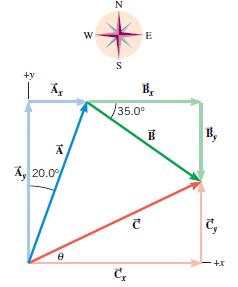Multiple-Concept Example 9 deals with the concepts that are important in this problem. A grasshopper makes four
Question:
Multiple-Concept Example 9 deals with the concepts that are important in this problem. A grasshopper makes four jumps. The displacement vectors are (1) 27.0 cm, due west; (2) 23.0 cm, 35.0° south of west; (3) 28.0 cm, 55.0° south of east; and (4) 35.0 cm, 63.0° north of east. Find the magnitude and direction of the resultant displacement. Express the direction with respect to due west.
Concept Example 9
A jogger runs 145 m in a direction 20.0° east of north (displacement vector A(vector)) and then 105 m in a direction 35.0° south of east (displacement vector B(vector)). Using components, determine the magnitude and direction of the resultant vector C(vector) for these two displacements.
Reasoning Figure 1.22 shows the vectors A(vector) and B(vector), assuming that the y axis corresponds to the direction due north. The vectors are arranged in a tail-to-head fashion, with the resultant vector C(vector) drawn from the tail of A(vector) to the head of B(vector). The components of the vectors are also shown in the fi gure. Since C(vector) and its components form a right triangle (red in the drawing), we will use the Pythagorean theorem and trigonometry to express the magnitude and directional angle θ for C(vector) in terms of its components. The components of C(vector) will then be obtained from the components of A(vector) and B(vector) and the data given for these two vectors.
Knowns and Unknowns The data for this problem are listed in the table that follows:


Step by Step Answer:

Physics
ISBN: 9781119539636
11th Edition
Authors: John D. Cutnell, Kenneth W. Johnson, David Young, Shane Stadler





